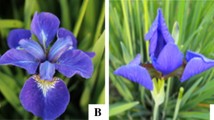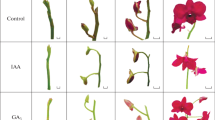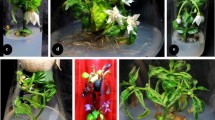Abstract
Flowering is a complex process which starts with the induction and development of the flower buds. For azalea (Rhododendron simsii hybrids), flower induction was hastened by the application of chlormequat and took place within 11 days after treatment. Subsequent flower bud differentiation was not altered by the application rate of the plant growth regulators (PGR) chlormequat and paclobutrazol, nor by temperature or light sum. There were however, large genotypic variations in flower bud differentiation rate. For all cultivars a linear phase until flower primordia were fully differentiated and the style started to enlarge (flower bud stage 7), was followed by a slower final development (to stage 8). The linear phase was fastest for the semi-early-flowering cultivars (‘Mont Blanc’, ‘M. Marie’ and ‘Otto’), requiring only 46 or 48 days to reach flower bud stage 7 after the first PGR treatment. Two late-flowering cultivars (‘Thesla’ and ‘Sachsenstern’) had the slowest differentiation, requiring 64 days to reach stage 7. The early-flowering cultivars (‘H. Vogel’ sports) and two late-flowering cultivars (‘Mw. G. Kint’ and ‘Tamira’) required 54 and 52 days, respectively, after the first PGR treatment to reach stage 7. To reach flower bud stage 8, a similar trend in velocity was seen, the semi-early-flowering cultivars requiring the least amount of days (17–18 days), the late-flowering cultivars ‘Thesla’ and ‘Sachsenstern’ requiring the highest amount of days (24 days) and the early-flowering cultivars and the late-flowering cultivars ‘Mw. G. Kint’ and ‘Tamira’ requiring an intermediate number of days (20–22 days).




Similar content being viewed by others
Abbreviations
- GA:
-
Gibberellin
- PGR:
-
Plant growth regulator
- DLI:
-
Daily light integral
References
Adams DG, Roberts AN (1968) Time of flower initiation in Rhododendron “Roseum Elegans” as related to shoot and leaf elongation. HortScience 3:278–279
Bodson M (1983) Effect of photoperiod and irradiance on floral development of young plants of a semi-early and a late cultivar of azalea. J Am Soc Hortic Sci 108:382–386
Bodson M (1989) Régulation et mécanismes de contrôle du développement reproducteur de l’azalée (Rhododendron sp.). I.R.S.I.A. publication Brussels, Belgium
Cheon K-S, Nakatsuka A, Kobayashi N (2011) Isolation and expression pattern of genes related to flower initiation in the evergreen azalea, Rhododendron × pulchrum “Oomurasaki”. Sci Hortic 130:906–912
Criley RA (1969) Effect of short photoperiods, cycocel, and gibberellic acid upon flower bud initiation and development in azalea “Hexe”. J Am Soc Hortic Sci 94:392–395
De Keyser E, De Riek J, Christiaens A, Van Labeke MC, Pauwels E, Gobin B (2013) Gene expression profiling of candidate genes for flowering initiation and dormancy breaking in Rhododendron simsii hybrids. Acta Hortic 990:187–192
Gent MPN (1995) Paclobutrazol or uniconazol applied early in the previous season promotes flowering of field-grown Rhododendron and Kalmia. J Plant Growth Regul 14:205–210
Goetsch L, Eckert AJ, Hall BD (2005) The molecular systematics of Rhododendron (Ericaceae): a phylogeny based upon RPB2 gene sequences. Syst Bot 30:616–626
Goldberg-Moeller R, Shalom L, Shlizerman L, Samuels S, Zur N, Ophir R, Blumwald E, Sadka A (2013) Effects of gibberellin treatment during flowering induction period on global gene expression and the transcription of flowering-control genes in Citrus buds. Plant Sci 198:46–57
Hanano S, Goto K (2011) Arabidopsis TERMINAL FLOWER1 is involved in the regulation of flowering time and inflorescence development through transcriptional repression. Plant Cell 23:3172–3184
Hoover E, De Silva N, McCartney S, Hirst P (2004) Bud development and floral morphogenesis in four apple cultivars. J Hortic Sci Biotech 79:981–984
Katz E, Ziv O, Venkatachalam R, Shlomo E, Halevy AH, Weiss D (2003) Promotion of Globularia sarcophylla flowering by uniconazol, an inhibitor of gibberellin biosynthesis. Sci Hortic 98:423–431
Keever GJ, Foster WJ (1991) Uniconazole suppresses bypass shoot development and alters flowering of two forcing azalea cultivars. HortScience 26:875–877
Koutinas N, Pepelyankov G, Lichev V (2010) Flower induction and flower bud development in apple and sweet cherry. Biotechnol Biotechnol Equip 24:1549–1558
Larson R, Biamonte L (1972) Response of azaleas to precisely controlled temperatures. J Am Soc Hortic Sci 97:491–493
Marafon AC, Herter FG, Hawerroth FJ, Silva A (2010) Floral bud initiation and development of three pear tree (Pyrus sp.) cultivars in two subtropical regions during the summer period. Acta Hortic 872:121–126
Marosz A, Matysiak B (2005) Influence of growth retardants on growth and flower bud formation in rhododendron and azalea. Dendrobiology 54:35–40
Meijón M, Rodríguez R, Jesús Cañal M, Feito I (2009) Improvement of compactness and floral quality in azalea by means of application of plant growth regulators. Sci Hortic 119:169–176
Meijón M, Cañal MJ, Valledor L, Rodríguez R, Feito I (2011a) Epigenetic and physiological effects of gibberellin inhibitors and chemical pruners on the floral transition of azalea. Physiol Plant 141:276–288
Meijón M, Feito I, Valledor L, Rodríguez R, Cañal MJ (2011b) Promotion of flowering in azaleas by manipulating photoperiod and temperature induces epigenetic alterations during floral transition. Physiol Plant 143:82–92
Meilan R (1997) Floral induction in woody angiosperms. New Forest 14:179–202
Oh W, Cheon IH, Kim KS, Runkle ES (2009) Photosynthetic daily light integral influences flowering time and crop characteristics of Cyclamen persicum. HortScience 44:341–344
Pettersen H (1972) The effect of temperature and day length on shoot growth and bud formation in azaleas. J Am Soc Hortic Sci 97:17–24
Pettersen H (1973) Bud formation in azalea. Acta Hortic 31:27–34
Pettersen H, Kristoffersen T (1969) The effect of daylength and temperature on flowering in the azalea cultivars ‘Red Wing’ and ‘Reinhold Ambrosius’. Acta Hortic 14:27–38
Rademacher W (2000) Growth retardants: effects on gibberellin biosynthesis and other metabolic pathways. Annu Rev Plant Phys 51:501–531
Randous M, Jeauffre J, Thouroude T, Vasseur F, Hamama L, Juchaux M, Sakr S, Foucher F (2012) Gibberellins regulate the transcription of the continuous flowering regulator, RoKSN, a rose TFL1 homologue. J Exp Bot 63:695–709
Ranney TG, Bir RE, Conner JL, Whitman EP (1994) Use of paclobutrazol to regulate shoot growth and flower development of ‘Roseum Elegans’ Rhododendron. J Environ Hortic 12:174–178
Sønsteby A, Heide O (2013) Variation in seasonal timing of flower bud initiation in black currant (Ribes nigrum L.) cultivars of contrasting geographic origin. J Hortic Sci Biotechnol 88:403–408
Takeda F, Strik BC, Peacock D, Clark JR (2002) Cultivar differences and the effect of winter temperature on flower bud development in blackberry. J Am Soc Hortic Sci 127:495–501
Väinölä A, Junttila O (1998) Growth of Rhododendron cultivars as affected by temperature and light. J Hortic Sci Biotechnol 73:812–821
Acknowledgments
This research was funded by the Government of Flanders (IWT-project LANDBOUW 070598/PCS). The authors would like to thank André De Neve and Dirk De Cock of the PCS Ornamental Plant Research for technical support.
Author information
Authors and Affiliations
Corresponding author
Rights and permissions
About this article
Cite this article
Christiaens, A., Pauwels, E., Gobin, B. et al. Flower differentiation of azalea depends on genotype and not on the use of plant growth regulators. Plant Growth Regul 75, 245–252 (2015). https://doi.org/10.1007/s10725-014-9948-2
Received:
Accepted:
Published:
Issue Date:
DOI: https://doi.org/10.1007/s10725-014-9948-2




